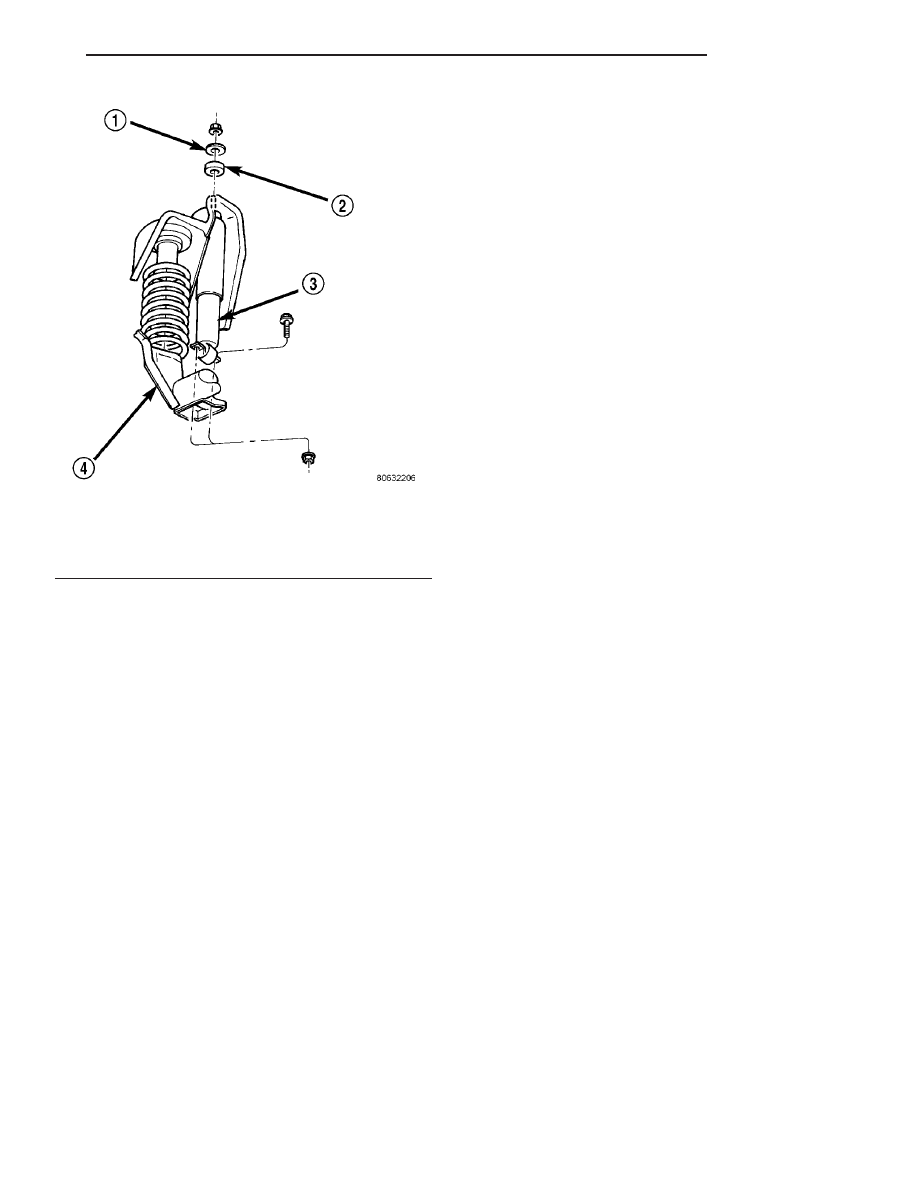Jeep Wrangler TJ. Manual - part 204

(3) Install the upper grommet and retainer on the
stud and install the nut and tighten to 23 N·m (17 ft.
lbs.).
SPRING
DESCRIPTION
The coil springs mount up in the wheelhouse which
is part of the unitized body bracket. A rubber dough-
nut isolator is located between the top of the spring
and the bracket. The bottom of the spring seats on a
axle pad.
OPERATION
The coil springs control ride quality and maintain
proper ride height. The isolators provide road noise
isolation.
REMOVAL
(1) Raise and support the vehicle.
(2) Remove the wheel and tire assemblies.
(3) Position a hydraulic jack under the axle to sup-
port it.
(4) Remove the front shocks at the lower mount-
ings, (Refer to 2 - SUSPENSION/FRONT/SHOCK -
REMOVAL).
(5) Remove the ABS wire mounting brackets at the
axle. (if equipped)
(6) Remove lower suspension arms mounting nuts
and bolts from the frame, (Refer to 2 - SUSPEN-
SION/FRONT/LOWER
CONTROL
ARM
-
REMOVAL).
(7) Remove the track bar from the axle bracket,
(Refer to 2 - SUSPENSION/FRONT/TRACK BAR -
REMOVAL).
(8) Remove the right side of the drag link from the
right side knuckle, (Refer to 19 - STEERING/LINK-
AGE/DRAG LINK - REMOVAL).
(9) Lower the axle until the spring is free from the
upper mount.
NOTE: Rotation of the spring and prying down
slightly on the axle will aid in removal.
(10) Remove the coil spring retainer clip and
remove the spring.
(11) Remove the upper spring isolator. (if needed)
(12) Pull jounce bumper out of mount. (if needed)
INSTALLATION
(1) Install jounce bumper into mount.
(2) Install the spring isolator.
NOTE: Rotation of the spring and prying down
slightly on the axle will aid in installation.
(3) Position the coil spring on the axle pad. It may
be necessary to rotate the spring while installing.
(4) Install
the
spring
retainer
clip
and
bolt.
Tighten bolt to 21 N·m (16 ft. lbs.).
(5) Raise the axle into position until the spring
seats in the upper mount.
(6) Install the shock at the axle, (Refer to 2 - SUS-
PENSION/FRONT/SHOCK - INSTALLATION).
(7) Install the ABS wire mounting brackets at the
axle (if equipped).
(8) Install the track bar to the axle bracket, (Refer
to 2 - SUSPENSION/FRONT/TRACK BAR - INSTAL-
LATION).
(9) Install the lower suspension arms to the frame.
Install mounting bolts and nuts finger tight, (Refer to
2 - SUSPENSION/FRONT/LOWER CONTROL ARM
- INSTALLATION).
(10) Install the drag link to the right side knuckle,
(Refer to 19 - STEERING/LINKAGE/DRAG LINK -
INSTALLATION).
(11) Remove the hydraulic jack from under the
axle.
(12) Install the wheel and tire assemblies, (Refer
to 22 - TIRES/WHEELS/WHEELS - STANDARD
PROCEDURE).
(13) Remove the supports and lower the vehicle.
(14) Tighten the lower suspension arms nuts to
115 N·m (85 ft. lbs.) at normal ride height with the
vehicle weight.
Fig. 8 Coil Spring & Shock Absorber
1 - RETAINER
2 - GROMMET
3 - SHOCK
4 - FRONT AXLE
TJ
FRONT
2 - 13
SHOCK (Continued)